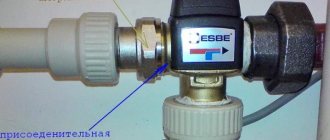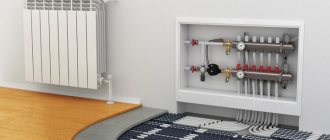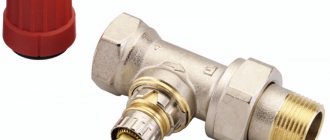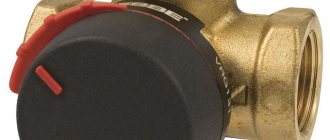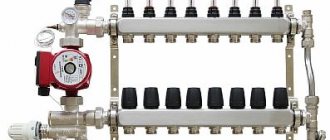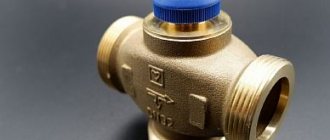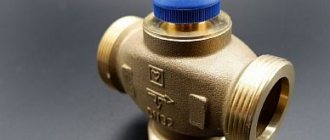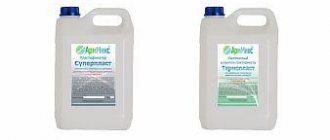Three-way thermostatic mixing valve is a device for maintaining a stable water temperature by regulating the cold and hot inlet flows. There are valves on sale with different operating principles, but most often the role of a regulator is played by a bimetallic element that deforms when the temperature changes. The thermostatic mixing valve can also be controlled by an electric servomotor. Such devices have much greater throughput and response speed, but their price is higher.
Place and role of mixing valves in the heating system "warm floors"
The main task that consumers have to face when deciding to install heated floors in their home is to achieve the required coolant temperature. For radiators, water at a temperature of 750C is quite acceptable, which cannot be said about pipes that are laid in the thickness of a concrete screed.
Important! Excessive heating of the concrete screed leads to a deterioration in the temperature balance inside the heated room. At high temperatures, flooring (in most cases wood-based) quickly loses its aesthetic and technological qualities, becoming unusable.
In accordance with sanitary standards, the normal heating temperature of heated floors should not exceed 260C. Then the middle layers of the air mass inside the room warm up to comfortable values of 20-220C. In order to obtain such temperature parameters, the water entering the loops of the water circuit must be heated to 500C. Slightly less than 50% of the thermal energy of the heated water is spent on heating the layered cake of the heated floor. Taking into account the thickness of the concrete layer, material and type of floor covering, the temperature on the floor surface decreases.
A mixing unit, which is a set of interconnected instruments and devices, helps to achieve a significant reduction in the temperature of the boiler water at the entrance to the heating water circuits. One of the main roles in the operation of the mixer is played by the thermomixing valve, which mixes water for the heated floor. Thanks to this small device, two streams of water are mixed, cold and hot, so that the output is water at the required temperature. Valves installed in mixing units are of two types, three-way and two-way. Each type of crane performs its own tasks and functions determined by the technological process. Which device is best to use for your heated floors? What is behind the choice of the type of mixing and control device?
Thermostatic valve and control valve - differences
The use of thermal valves on a single-pipe heating system is especially important, but only if it is not flow-through. That is, if there are jumpers at the junction of the radiators - bypasses. It happens that there are no bypasses. As a result, the coolant sequentially passes through all radiators, one after another. Installing a thermostatic valve on such a system can only cause harm. Because the thermostatic valve will turn off all radiators located after it. Therefore, if for some reason it is very necessary for a flow-through system, it is better to install a control radiator valve. And don't cover it completely.
The difference between a control valve and a thermostatic valve is the ability to adjust the gap for the passage of coolant - more or less. The thermostatic valve, on the contrary, can only be in two positions. Firstly, it is open to a certain, previously adjusted level. Secondly, it is completely closed. Therefore, there is no need to install a thermal valve on a flow-through heating system without bypasses. Since, when the valve is closed, the circulation of coolant throughout the system will stop. This will create cooling and unbalance the heating system. It will also have a negative impact on the heating boiler. The situation can be aggravated by the absence or poor functioning of the safety valve. That is, a breakthrough may occur in one of the weak points of the system.
What materials are they made from?
Corrosion-resistant metals are used to make the thermostatic valve body:
- Brass.
- Bronze.
- Stainless steel.
Additionally, the surfaces of brass products are nickel-plated, and the bronze body is either also nickel-plated or coated with a layer of chrome.
Advantages and disadvantages
The advantages of installing thermostatic valves in the heating system include the following factors:
- Energy independence of the device.
- Compactness.
- High precision temperature control.
- Easy to operate and highly reliable.
- Aesthetic appearance.
- The optimal combination of price and functionality.
The disadvantages of using thermostatic valves are:
- Difficulty setting up.
- There is a danger of the thermal head malfunctioning under the influence of a draft or a nearby stove.
Using drives
In addition to the thermostatic head, the valve can be controlled in other ways. The first of them is manual, when the depth of pressing of the rod is determined by turning the handle outside the body. Not the best option and is only suitable if the temperature of the water entering the pipes is constant. Another option is control using a servo and electric drive, receiving commands from the controller. To work together with different drives, another type of valve is used - rotary valves, whose device is shown in the figure:
This 3 outlet valve is very similar to a regular motorized ball valve
There is a certain similarity here with a ball valve, only the working rotary element has a different hole shape to allow coolant to flow in two directions at once. The operating principle here is simple: the axis rotates to the required angle, rotated by the drive. The latter is controlled by a controller that receives impulses from one or more sensors. Typically, valve actuators are installed in complex or automated heating systems with weather control.
Types and their structure
In a thermostatic distribution valve installed on a heated floor, the heated water is mixed with cooled water from the return pipe. This process is continuous as long as the heating is on.
There are two-way and three-way mixing valves for underfloor heating. They also differ in the method of mixing and the direction of flow.
Two-way
The two-way thermostatic valve is an improved manual type model. It can be hydraulic, pneumatic or electrically driven.
The design is simple, but capable of effectively regulating the temperature level of the coolant in automatic mode. The device is mounted in the heating system, instead of a manual valve.
Main advantages:
- Automatic reduction of liquid temperature level;
- Simplicity of design and low price;
- Easy installation.
Disadvantages - the possibility of installing it on pipelines with a small size. If you use this faucet when installing heating in a room with a large area, the thermostat will function intermittently. A two-way valve is more often used if heated floors act as additional heating.
The valve device is a brass or bronze body, with one or two seats. A double-seated valve can completely shut off the flow of water.
The device is equipped with a thermostatic head with a scale. The head position can be changed manually or automatically. Manual models are simple and inexpensive. More modern devices work automatically.
The two-way valve operates according to the following principle - the coolant from the return line is again supplied to the floor pipes, but before this, a device is activated that opens the supply of heated water. The two flows are mixed inside the housing to the desired degree, then the temperature sensor is triggered and the shutter automatically closes the hole with the hot coolant.
The valve consists of a plunger and a seat. The plunger has a disc, needle and rod shape. It is located perpendicular to the movement of the fluid.
Three-way valve
The operating principle of a three-way thermostatic valve for floor heating is that cooled water from the return line is added to the hot water coming from the boiler.
The valve is designed for heating systems that are installed in large rooms. They have the same advantages as two-way valves. Particularly worth noting is the ease of adjusting the water temperature for heated floors.
But this thermostatic valve also has a minus - if the thermostat is triggered, the valve opens completely, thereby allowing hot coolant to enter the circuits. And this can cause overheating of the heating system, and even rupture of pipes. In addition, it has a lower flow capacity than a two-way valve.
Three-way thermostatic mixing valves are available in brass and bronze. They are equipped with a thermal head or thermostat, and can have an electric drive or a servo drive. The design is a faucet with two inlets and an outlet. Inside the case there is a mixing chamber, on which there is a thermostat with a regulator on which there is a digital panel. A thermal valve is connected in front of the manifold.
Operating principle of three-way thermostatic valve:
- heated water moves through the right and front pipes - if its heating degree meets the required parameters;
- if the temperature of the liquid increases or decreases, the thermostat comes into operation, it sets the rod in motion, as a result, cooled water is mixed with hot water;
- after reaching the set temperature, the front hole opens completely.
It should be said that when the device is turned on, the water flow voltage does not change. This leads to a uniform change in the temperature of the liquid supplied to the line.
Features of Three Way Valve
Mixing fluid flows, which a thermostatic mixing valve allows, makes it possible to direct flows with a stable, standard temperature into the underfloor heating system. This operation is performed automatically. For mixing that takes place inside the device, already cooled liquid from the “return” is added to the hot water.
Description of three way valve
Operation occurs in the following sequence:
Operating principle of three-way valve
- hot water flows to the collector included in the underfloor heating system;
- when passing through the thermo-mixing valve, the degree of heating of the liquid is determined;
- if the water temperature is higher than the set one, then a passage opens into which the cooled liquid enters;
- two flows are mixed inside;
- after reaching the desired value, the cold water passage closes.
Among the disadvantages of three-way valves, there is the possibility of sudden temperature jumps that occur during the start-up of heated water, which negatively affects the condition of the pipeline.
Heat supply and treatment to the floor of a three-way mixer
This faucet, made of brass, has three strokes in its design, which determine the use of different methods of mixing liquid flows, depending on which there are three types of three-way valves.
Overall and installation dimensions of the three-way valve
- Valve with the thermostat function required for heated floors. Such a device not only regulates the intensity of the mixed flows, but also ensures that the system maintains a given temperature. This function is facilitated by the presence of a heat-sensitive element, which, by detecting the degree of heating of both flows entering the tap, changes the cross-section of the holes.
- The three-way thermostatic valve of the second type is distinguished by the fact that it provides regulation of the supply intensity of only the hot flow. The package includes a thermal head with a remote sensor.
- You can also select a mixing valve from the assortment of three-way models that does not automatically maintain the set temperature.
By mixing method
Mixing taps for heated floors, depending on the mixing method, are:
- With a thermostat function - with it it is possible to achieve and maintain the desired degree of heating of the coolant, since the device is able to regulate both flows (heated and cooled). The thermostat in the mixer, reacting to the level of heating of the liquid, opens or closes the hole through which heated or cooled coolant is supplied. In addition, the mechanism is designed in such a way that in the absence of cold water, the automation shuts off the flow of hot water.
- Thermostatic - the device is equipped with a sensitive thermal head that has an external temperature sensor, it is located in each line. The operation of the valve is to determine the water temperature and send a command to the actuator.
Gas or liquid
The effectiveness of a thermostatic valve depends on the properties of the substance in the bellows. Gas-filled thermoelements are more accurate and reliable. They respond faster to temperature changes, but are more difficult to produce and therefore more expensive.
Liquid ones work a little slower, but are easier to manufacture. The advantages of liquid thermoelements also include the high accuracy of transfer of the internal pressure of the bellows to the thermostatic valve stem.
With remote sensor
Thermal valves with a remote sensor are designed for installation in radiators with a bottom connection or located in a niche. The thermostatic head is mounted on the valve using a threaded connection, and the temperature sensor is attached to the wall in any convenient place. The head and sensor are connected to each other by a capillary tube.
Such models maintain temperature more accurately, but are more expensive than others.
Types of 3-way valves
All thermostatic three-way valves for heating are divided into 3 types according to their design and operating principle:
- mixing;
- dividing;
- switching.
The purpose of each of the 3 varieties can be judged by its name. The first type of valve mixes two coolant flows with different temperatures, the second one separates, the third switches water between 2 lines. It is not difficult to recognize them externally; usually the principle of operation is depicted on the body in the form of a picture. Here's what a three-way mixing valve looks like:
The nameplate from Herz clearly shows the mixing of 2 flows, which means this is a mixing valve
A similar designation appears on the separating element. As for switching taps, there may not be an image on their body, but there are significant external differences in shape.
Separating (photo left) and switching (right) 3-way valve
By mixing or separating flows, the optimal temperature of the coolant supplied to the radiators of the heating system or underfloor heating circuits is achieved. Switching is used in gas double-circuit boilers, when heated water must be alternately directed to different heat exchangers.
How does automation work?
A thermostatic three-way valve for underfloor heating is connected in front of the manifold. A certain temperature heating mode is set on the sensor. The device starts working when the parameters are changed.
- The device consists of a semiconductor, which has the temperature of the coolant entering the line. Energy is transferred to the thermostat fluid.
- As the heat increases, the liquid expands and puts pressure on the rod, which lowers.
- In this case, the outlet from the hot pipe is closed and the outlet from the return circuit is opened.
- The cooled coolant enters the three-way mixer chamber, where it is combined with hot water from the boiler. The mixing process can take place according to a T-shaped pattern: hot and cold coolant flow enters the thermostatic mixing valve symmetrically from both sides. The liquid exits into the main line at an angle of 900. With an L-shaped design, hot water enters the mixing chamber from the side.
- The coolant temperature decreases. It enters the floor line cooled. The heating mode strives to reach the set norm.
- As the temperature drops, the liquid in the thermostat contracts. The spring-loaded rod straightens, closing the outlet of cold water that flows through the return pipe. Hot coolant again enters the main line.
When using servo drives, a device that operates from the network is connected to the mixing valve for heated floors. The sensor heats up and closes the electrical circuit. The plate is heated, which in turn transfers heat to the thermal fluid. It expands, pressing on the rod, which makes the poppet valves work.
When using a servo drive, the heating system changes operating mode within 3 minutes. If you use a thermal head as an automatic device, it will take up to 15 minutes to heat the liquid in the thermostat.
The operating principle of a two-way valve for underfloor heating is somewhat different. When the temperature in the main increases, the thermostat causes poppet valves or a ball device to operate, which completely blocks the outlet for hot water. The cooled coolant from the return pipe returns to the floor circuit.
When the temperature decreases, the valve opens hot water and closes the return flow. There is no mixing of the liquid. The principle of operation of a two-way thermostatic valve for underfloor heating is identical to manual switching of valves, but the system operates in automatic mode.
A three-way thermostatic valve for underfloor heating is installed in a heating system for a large heating area. The equipment is necessary for a boiler that heats water to a high temperature. A two-way valve is connected to the system as additional heating control for individual rooms.
Equipment for automatic control of the heating mode can be installed in a single-circuit or double-circuit heating system. This is convenient when using various types of heating, radiator and floor. The mixer is connected before the circulation pump. I recommend installing a water filter first. When connecting, use the threaded installation method.
How to choose equipment?
Thermostatic devices are selected depending on the throughput of the coolant. It must correspond to the volume of liquid that is pumped into the heating system. The data is indicated in the technical data sheet for the boiler.
For the hot and cold circuits, metal pipes with a diameter of 26 * 2 mm are used. The nozzles of a three-way mixer should have the same diameter. Otherwise, you will have to install adapters, which is not desirable for a heating system. The seams bear a high load. It is always necessary to ensure their tightness.
The liquid temperature in the floor line is 55-35 0C. The equipment is selected depending on the specific thermal regime that can be set on the thermostat. Radiator heating requires a wider temperature range, up to 80 0C.
To control the temperature in a room with water underfloor heating, thermostatic equipment is used. Automation will facilitate the operation of the heating system, ensure a normal microclimate in individual rooms of the cottage, and save energy.
When using the device with software, it becomes possible to regulate the temperature of the floor line depending on the time of day and days of the week.
Budget elements with fixed water temperature
In simple heating systems of country houses that receive thermal energy from a TT boiler, it is allowed to install a three-way valve of a simplified type that operates autonomously. To operate, it does not need a thermal head with a temperature sensor, and there is no rod there. The control thermostatic element is installed inside the housing and is set to a certain outlet water temperature, for example, 60 or 50 °C (indicated on the housing).
Operating diagram and design of a valve with a built-in control element
A thermal mixing valve of this type always maintains a fixed temperature of the coolant at the outlet; this setting cannot be changed. This gives rise to the pros and cons of using such fittings:
- The advantage is a lower price than the cost of a unit with a thermal head. The difference is significant - about 30%.
- Disadvantage - it is impossible to regulate the heating of the exiting coolant. When the element is set at 55°C from the factory, it will always supply water at this temperature ±2°C.
Advice. Before purchasing a valve of a simplified design, carefully read the technical documentation for the solid fuel boiler; it often indicates the minimum temperature of the return coolant. You will find more information on the use of mixing fittings in a separate publication.
How to choose a thermal head?
The floor covering heating system has a mixing unit, the most important element responsible for changing the parameters of the heating circuit. This is due to the fact that the moisture from the heating equipment enters the pipeline too hot, sometimes up to 90 degrees Celsius, and inside the screed there can only be a maximum of 40 degrees Celsius.
In order not to overheat the system, a thermal head is installed on the damper, maintaining acceptable parameters of the coolant. The mixer is responsible for bringing together the temperatures of different flows, as a result, antifreeze or water of the required and permissible temperature enters the water circuit.
Types of thermal heads
Depending on the substance in the bellows, thermal heads can be gas, liquid or paraffin based. Liquid - inertial, working slower, taking a long time to heat up and cool down, but the most accurate.
Gas ones have a large error and are vulnerable to drafts. Inside the head there is a mnemonic diagram on which zones with temperatures are marked.
The thermal head can be controlled mechanically or electronically. Manual, mechanically controlled, have a radial scale with marks of 2...5 degrees. Turning the knob will increase the distance between the elements and increase the pressure on the rod.
Electronic devices are controlled by a display, and an electric drive presses on the rod. Such equipment is more expensive, but is highly accurate.
The thermostat contacts the surface in several ways, so the thermal head can be a surface-mounted one, with an air sensor, or an immersion type.
The thermostat heats up at the place of fixation, and the overhead and air thermostats are connected to the sensor by a sealed capillary-type tube. The bellows expands from the heating of a canister located remotely - such units are used in heated floors.
Installation diagram
Water heated floors today are a common system for heating a home; different schemes are used for its arrangement.
Three-way valve. We install it correctly.
Heated floor equipment with three-way valve
Installation of underfloor heating with the installation of a three-way thermostatic valve is suitable for mixed heating systems. Radiator (water temperature 80 degrees) and underfloor heating (the liquid should not heat above 50 degrees).
Thermal head for a heating radiator - operating principle, different types of devices, how to choose and install.
The question arises - how to cool the water from 80 to 50 degrees. This is what the three-way thermostatic valve is designed for. It is attached to the supply pipe, and a circulation pump is connected behind it.
The working process is as follows:
- waste cooled coolant is supplied from the return pipe;
- in the mixing chamber it is mixed with the hot liquid to a predetermined level;
- then the water flows into the branches of the floor.
The disadvantage of this method is the inability to dose the waste water mixture, and this leads to the entry of overheated or underheated coolant into the main line. Plus - easy installation and low price of equipment.
There are two installation schemes for a water heating floor with a three-way thermostatic valve; they differ in the direction of flow:
- T-shaped (symmetrical) - heated and cold coolant is supplied from the sides, water is mixed in the center of the valve body, and comes out in the middle.
- L-shaped or asymmetrical - the heated liquid enters from the side, and the cooled liquid from below. Mixed water comes out from the side, opposite the hot one.
Both valves are compact and widely used in warm hydrofloors.
Two way thermostatic return flow valve. Installation on heated floor!!!
Changing operating modes of heated floors
The thermostat is an effective solution for monitoring the water temperature in the heating circuit. This method is inexpensive and accessible to almost every owner. The boiler heats the water to 90 degrees, and water should flow to the floors at a temperature twice as low.
The desired degree can be achieved thanks to the thermostatic head:
- The supply of hot water is short-term - the water fills the pipeline, the supply ends until it cools to an acceptable temperature;
- Constant water supply with the addition of cool coolant from the return pipe.
Periodic short-term supply
With a short-term water supply, the system works in a small space - a bathroom, ceramic floor in the toilet, shower room and other places. At the supply point there is a valve with two strokes, a remote-type floor sensor and a thermal head.
As soon as the circuit is filled with coolant, the sensor is triggered and the flow is blocked by the valve. After some time, the screed will cool down, the valve will open again and hot water will fill the system. This circuit is economical and can replace the mixer unit.
For heated floors, special thermal heads from the RTL series have been developed, without an external sensor. They are installed on the return line to maintain the set water temperature without depending on the heating of the floors. By installing this model of thermostat, the automation changes the threshold heat values (no more than 40 degrees Celsius).
The installation feature is installation in an exclusively horizontal position. Experts from Moscow do not recommend setting the water level in the floors lower than the temperature in the room.
Periodic short-term injections of water into the circuit allow you to maintain stable movement along the coolant circuit without overheating the system.
Constant coolant supply
A constant supply of water requires the installation of a three-way valve in the system, complemented by a floor sensor and a thermal head. Using a tee, a connection is made from the return to the third stroke of the mixing unit. The direct water supply must always be open, so the valve must be installed professionally and correctly.
Experts recommend installing the thermal head on a three-way valve using a locking type axle box. When the sensor heats up, the valve stem moves and a gap is formed inside. This gap receives cool water from the return line.
This sequence of work allows the coolant to stably enter the circuit, while the temperature remains within acceptable limits. Due to the continuity of the flow, the floor covering quickly heats up to 28 degrees Celsius and remains comfortable for the owner, and the circuit does not overheat.
Pipes and screed will last longer due to the absence of excessively high temperatures. The addition of cold coolant is important for heating large rooms where a comfortable temperature is needed.
Our range
The Santekhkomplekt online store offers a wide range of thermostatic mixers from leading European manufacturers. From us you can buy products from Danfoss (Denmark), Esbe (Sweden) and Giacomini (Italy), known throughout the world for their meticulous attitude to quality.
All products are made from corrosion-resistant alloys that can withstand highly acidic water, which is typical for Moscow. Quality control of the control rod allows the listed manufacturers to achieve its high precision and durability, providing it with stable reliability for many years.
Large areas
Installing heated floors as the main type of heating involves installing full-fledged mixing equipment that is capable of dividing the flows into two - heated floors and central heating. Here, three-way thermostatic valves with full flow into the system are required.
Experts recommend installing one common circuit where the working fluid is pumped by a pump. At the entrance to the heated floor there is a mixing valve. It is controlled by a special temperature regulator. The mixing valve is installed between the bypass and return. A sensor at the top of the valve regulates the set temperature.
If the temperature rises, the mixing valve closes the return flow. Further circulation of the working fluid occurs in the coolants of the heated floor.
Sources
- https://ProUteplenie.com/otoplenie/termostaticheskiy-klapan-dlya-teplogo-pola-vidy-i-kak-vybrat-shemy-montazha
- https://bph-saratov.ru/otoplenie/termostaticheskij-ventil.html
- https://OtoplenieBlog.ru/oborudovanie/teplyj-pol/kak-vybrat-termostaticheskij-klapan-dlya-tyoplogo-pola.html
- https://seti.guru/termogolovka-dlya-teplogo-pola-vodyanogo
What do you think of this article?
Application area
Underfloor heating systems are increasingly popular in residential buildings today, but without a control valve it is impossible to ensure proper heating. A three-way tap is an element designed to adjust the heating level in a water floor that is filled with screed.
The valve is installed both as a complete set with a mixing and distribution unit, and as an independent device. In small rooms (bathtub, toilet, kitchen), there is no point in installing a multifunctional collector - it is expensive and not justified.
A three-way thermomixing valve can control the temperature and regulate the volume of liquid for such rooms.
Main areas of use:
- In a radiator heating system.
- In the DHW system.
- In warm floors.
Selection criteria
When choosing a mixing valve, it is advisable to focus on several indicators.
- Room area.
For small rooms - bathroom, toilet, it is not always recommended to purchase a more expensive thermo-mixing valve, since it is enough to install a familiar valve. Large rooms with warm water floors will require mixers that automatically regulate the temperature of the heating fluid. Esbe three-way valves model VTA320 - Cross-sectional dimensions. This indicator must be taken into account when selecting a thermostatic valve, ensuring precise connection to the heating system. If there is no device with the required diameter in the assortment offered in the store, then special adapters are purchased.
- Possibility of obtaining an automatic operating mode.
- Bandwidth. This parameter is calculated at the design stage of the heated floor. Based on the obtained values, a mixing valve is selected that can withstand the required load.
Electronic thermostats
There is a minor numeric display and a row of keys. The display shows the current characteristics of the system, or those being set. The keys (often with up and down arrows) are designed to change the temperature. Programmable temperature controllers make it possible to maintain a stable floor temperature; you can automatically change it on specific days of the week or time of day.
There are modifications that, along with the stationary control unit on the wall, have a portable control panel. Certain models make it possible to manage work via a personal computer or tablet, which is quite convenient. These devices can control floor heating.
A water-insulated floor is the best heat resource; with its help, convenience and comfort are introduced into the atmosphere of the home.
Features of operation
When operating a heated floor mixing valve, there are special points. The main one is the mandatory installation of a filter. In addition, it is not recommended to place a mixer with a thermal head in a manifold group that serves more than one room or is located in an adjacent room. A device with a remote temperature sensor placed in a heated room is suitable.
The mixing valve is the main element in the water heated floor system. The quality of room heating depends on how correctly it works. Therefore, its selection and installation must be approached responsibly. If you are not confident in your abilities, then it is better to invite a professional.
Nuances of choosing a device
The following guidelines are general when selecting a suitable three-way valve:
- Reputable manufacturers are preferred. Often on the market you can find low-quality shut-off valves from unknown companies.
- Copper or brass products have greater wear resistance.
- Manual control is more reliable, but less functional.
The key point is the technical parameters of the system in which it is supposed to be installed. The following characteristics are taken into account: pressure level, the highest temperature of the coolant at the point of installation of the device, the permissible pressure drop, the volume of water passing through the valve.
Only a valve with the correct capacity will work well. To do this, you need to compare the performance of your plumbing system with the throughput coefficient of the device. It is mandatory indicated on each model.
For rooms of limited space, such as a bathroom, it is irrational to choose an expensive valve with a thermomixer.
Large areas with heated floors require a device with automatic temperature control. The guideline for selection should also be the product’s compliance with GOST 12894-2005 .
Functions
Water heated floors have significant differences from standard radiator heating. The floor pipeline, which lies in a cement screed, requires water at a certain temperature level, much lower than that circulating in the radiators. Therefore, it is necessary to install a three-mix running unit, in which the coolant will be brought to the required degree.
Bringing the liquid to the required degree of heating that meets the standards for underfloor heating (which ranges from +35 to 55 degrees) is the main function of a three-way thermomixing valve.
Procedure for setting up the mixing unit
When work has been completed in accordance with the connection diagram for the mixing unit for a heated floor, its operation requires adjustment. The installation process of the units is simple; you only need to join the pipes.
As for the settings, this work is performed in a certain sequence.
Stage 1 . The servo drive (thermal head) is removed so that it does not affect the unit during setup.
Stage 2 . The bypass valve is set to a maximum of 0.6 bar. If the device accidentally triggers while setting up, the result will not be correct. For this reason, it should be placed in a position where this cannot happen.
Stage 3 . Next, determine the installation of the balancing valve. Number 1 indicates the radiator circuit, 2 indicates the circuit of the heated floor system.
To do this, use the formula:
t1 – temperature of the working medium in the supply pipeline of the high-temperature circuit;
supply t2 – temperature of the coolant in the supply pipe of the floor circuit;
t2rev – water temperature in the return of the heated floor circuit.
Kυт – coefficient equal to 0.9.
If, for example, t1 = 95 °, t2 feed = 45 ° and t2rev = 35 ° are substituted into the formula, then Kυb will be equal to 4.05.
This value must be set on the balancing device.
Stage 4 . Next, the pumping equipment is set up. To do this, you will need to find out the water flow in the floor heating system together with the collector and the amount of pressure loss in the circuit behind the mixing unit.
The heat carrier flow in the floor circuit is determined using a simple formula:
G2 – coolant flow in the secondary floor heating circuit;
Q – the sum of the thermal power of devices that are connected after the mixing unit;
c – heat capacity of the coolant, in the case of water c = 4.2 kJ.
If we substitute the digital values into the formula, then G2 = 857 kg/hour or 0.86 m³/hour.
To find out the pressure loss in the heated floor circuit, a hydraulic calculation is done. The pump speed is determined using special graphs. First, mark the point corresponding to the flow rate and pressure of the pump. The curve above the obtained point reflects the speed of the pumping equipment.
The resulting flow rate is 0.86 m³/hour, and the pump pressure is 4.05 mV.st. The pressure loss in the circuits after the node is calculated with a margin of 1 mv.st., total ΔPн = ΔPс + 1 = 4.05 +1 mv.st.
When, when setting up a mixer for heated floors with your own hands, it was not possible to calculate the pump, this step is skipped. In this case, the pumping equipment is set to a minimum. If later, during the process of balancing the heating system, it becomes clear that the speed is not enough, then the pump is set to a higher parameter.
Stage 5 . Begin balancing the floor heating lines. First of all, close the balancing-shut-off valve on the radiator circuit. Next, remove the cap from the valve and turn it, moving clockwise until it stops, using the hex key.
The circuit branches are regulated using balancing valves. When there is only one line after the mixing unit, this process is not required.
Balancing is performed as follows:
- Open the regulators to maximum.
- On the branch where the flow deviation is the largest (the difference between the actual indicator and the design one), the valve is closed to the required value.
- The remaining branches of the system are regulated in the same way.
- If the flow goes wrong after balancing the branches, it still needs to be corrected.
- If it is not possible to set the flow rate even with the valves open, the pumping equipment should be switched to a higher speed.
Stage 6 . Connect the floor mixing unit with the rest of the heating devices. For this purpose, a balancing-shut-off valve, which was previously closed, is opened on the radiator circuit to a position capable of providing the required coolant flow.
When setting up a mixing unit for a heated floor with your own hands, this indicator can be controlled using flow meters or in the return pipeline.
The coolant flow in the radiator circuit is calculated using the formula:
All digital values are known, if you substitute them into the formula, then G1 = 142 kg/hour or 0.14 m³/hour.
Stage 7 . Start setting up the bypass valve. They set the pressure value on it, which should be 5 - 10% less than the maximum pressure of the pumping equipment at a given speed. This value can be found in the instructions for the pump. The bypass valve of the pumping equipment is opened only when it is working to build up pressure while there is no water flow. This device is set to a pressure of 0.54 - 5% = 0.51 bar.
Stage 8 . Check the correct functioning of the mixing unit. Confirmation of the uniform heating of the heated floor branches and the correctness of the temperature ratio in the circuits is the fulfillment of the following equation:
in this case, the index “p” denotes the calculated values, and the index “f” – the actual ones.
In the case where the equality is not satisfied, then close the balancing shut-off valve located on the radiator circuit by ¼ turn, after which the readings are taken again and calculations are performed.
If equality is observed, it is considered that the mixing unit is operating correctly. After this, the servo drive is returned to its place, protective caps are placed on all elements where necessary and the screw on the balancing device is tightened.
The mixing heating unit is placed in a manifold cabinet, which is usually located in a room where a heated floor is installed. It can also be placed next to the heating boiler, if distance allows. You can install the elements of the mixing unit yourself.
You need to know that a huge disadvantage of arranging a heated floor structure without a mixing unit and a collector is that then it is necessary to minimize the heat loss of water when moving it from the heater to the circuit, which will require a number of measures to insulate the building and its elements.
To constantly maintain a comfortable thermal balance in the house, an element such as a three-way valve on the heating system is included in the heating circuit, which evenly distributes heat throughout all rooms.
Despite the importance of this unit, it does not have a complex design. Let's look at the design features and operating principles of a three-way valve. What rules should you follow when choosing a device and what nuances are present in its installation.
Mechanical thermostat: operating principle
If the air space in the room is heated to the required level, the working sphere in the bellows expands under the influence of heat, which causes the hydraulic cylinder to straighten. The rod, combined with the bellows, rushes forward, exerting pressure on the hydraulic valve, pressing it closely against the through hole. In this case, the supply of coolant to the battery (heating) stops.
After the remaining media in the heating battery has cooled, the mixture (or gas) in the thermoelement is compressed, causing its walls to shrink, which leads to the opening of the valve. The heated coolant enters the system, then the course of action begins all over again.
